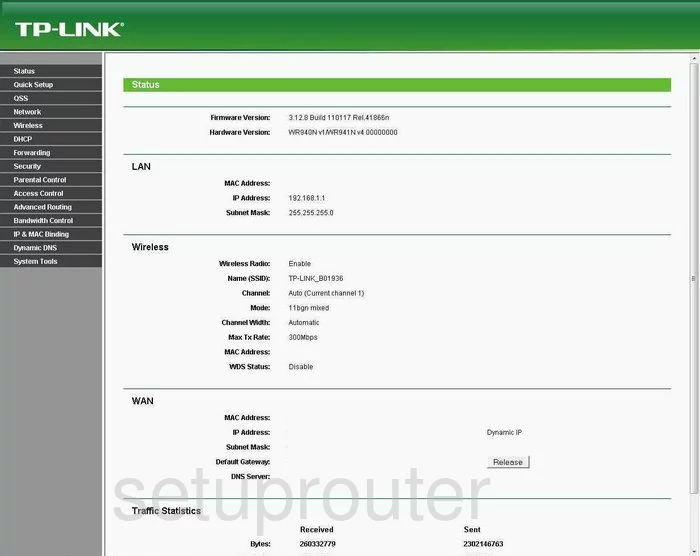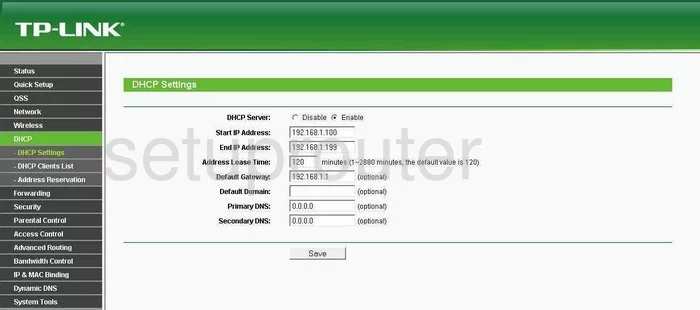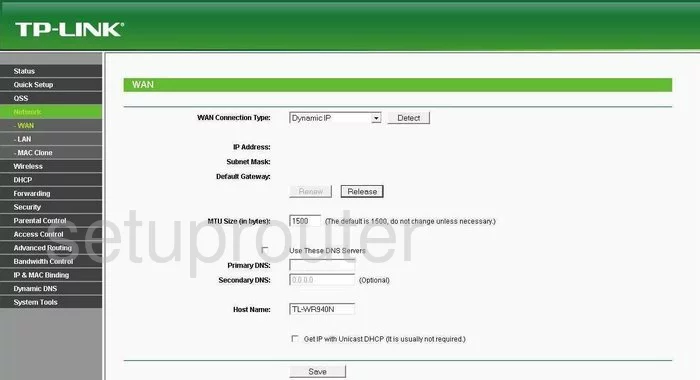This page shows how to change the DNS settings on the TP-Link TL-WR940N router.
Other TP-Link TL-WR940N Guides
This is the dns guide for the TP-Link TL-WR940N. We also have the following guides for the same router:
- TP-Link TL-WR940N - Reset the TP-Link TL-WR940N
- TP-Link TL-WR940N - How to change the IP Address on a TP-Link TL-WR940N router
- TP-Link TL-WR940N - TP-Link TL-WR940N User Manual
- TP-Link TL-WR940N - TP-Link TL-WR940N Login Instructions
- TP-Link TL-WR940N - Setup WiFi on the TP-Link TL-WR940N
- TP-Link TL-WR940N - Information About the TP-Link TL-WR940N Router
- TP-Link TL-WR940N - TP-Link TL-WR940N Screenshots
What is the DNS setting on a Router
When you connect a router to the Internet it gets a few settings from your ISP automatically. One of the settings that the ISP sets in your router is the DNS setting. DNS stands for Domain Name System and it is used to convert Internet names into actual IP addresses. For instance, when you go to "google.com", your are really connecting to an IP address that is mapped through DNS to a number such as:
- 173.194.33.73
This mapping happens automatically every time you visit any page on the Internet.
Why Change Your Router's DNS Setting
Some ISPs choose to abuse the DNS system and map unknown names to servers that they control. This can be done in a way that you don't know it is happening since your router is getting its DNS settings from your ISP. For instance, if you have one of these ISPs who is hijacking your DNS, and you try to surf the web to "some-random-site.com" and "some-random-site.com" does not exist, you might get a page back from your ISP with local advertisements on it.
By changing your DNS setting in your router you will effectively change the DNS setting for every computer on your network. This is because when a device is connected to your network your router automatically hands out its own DNS settings to that device. This way you can protect your entire network from ISP hijacking with just one setting.
What Should I Change My DNS To
There are 2 really great DNS servers on the Internet that you can choose from right now: Google Public DNS and OpenDNS. If you are not sure which one to pick then just use Google Public DNS.
When you change the DNS settings in your router, you usually have to enter a Primary and a Secondary setting. The secondary is only used if the primary can not be located. Here are common settings:
If you want to use Google Public DNS, use the following settings:
- Primary: 8.8.8.8
- Secondary: 8.8.4.4
If you want to use OpenDNS, use the following settings:
- 208.67.222.222
- 208.67.220.220
Login To The TP-Link TL-WR940N
To get started configuring the TP-Link TL-WR940N DNS page you need to login to your router. If you are already logged in you can skip this step.
To login to the TP-Link TL-WR940N, follow our TP-Link TL-WR940N Login Guide.
Change the DNS settings on a TP-Link TL-WR940N
If you followed our login guide above then you should see this screen.

Starting on the Status page of the TP-Link TL-WR940N you need to click the file on the left hand side of the page labeled DHCP. This opens up a few new links, pick the first one labeled DHCP Settings.
Configure the DNS section of your TP-Link TL-WR940N

You are now on a page like the one you see above. This DNS server is the one your computer uses on a regular basis. Enter the DNS server address you have chosen to become the primary address in the box labeled Primary DNS. Whatever address you enter here becomes the primary and will always be accessed first.
Under that is the Secondary DNS space. Type in your choice of DNS Server addresses here that you want to be the secondary DNS Server address. Remember the address entered here is a back-up and only used if the primary can't be located.
Before leaving this page, click the Save button.
The other DNS server we'll have you set is the DNS Server that deals mostly with updates. Click the file on the left labeled Network, then WAN.

You should now be on the WAN page. To set this DNS server, tick the box labeled Use These DNS Servers.
Now you can make the necessary changes. In the box labeled Primary DNS, enter the same primary address you entered earlier.
Then in the Secondary DNS space, again enter the same secondary address you entered earlier.
That's it, simply click Save before you exit.
Possible Problems when Changing your DNS settings
Most devices on your network will not begin using the new DNS settings until they have been rebooted. After rebooting a device you can go to it's network settings and verify that it is using the DNS servers that you specified.
Other TP-Link TL-WR940N Info
Don't forget about our other TP-Link TL-WR940N info that you might be interested in.
This is the dns guide for the TP-Link TL-WR940N. We also have the following guides for the same router:
- TP-Link TL-WR940N - Reset the TP-Link TL-WR940N
- TP-Link TL-WR940N - How to change the IP Address on a TP-Link TL-WR940N router
- TP-Link TL-WR940N - TP-Link TL-WR940N User Manual
- TP-Link TL-WR940N - TP-Link TL-WR940N Login Instructions
- TP-Link TL-WR940N - Setup WiFi on the TP-Link TL-WR940N
- TP-Link TL-WR940N - Information About the TP-Link TL-WR940N Router
- TP-Link TL-WR940N - TP-Link TL-WR940N Screenshots